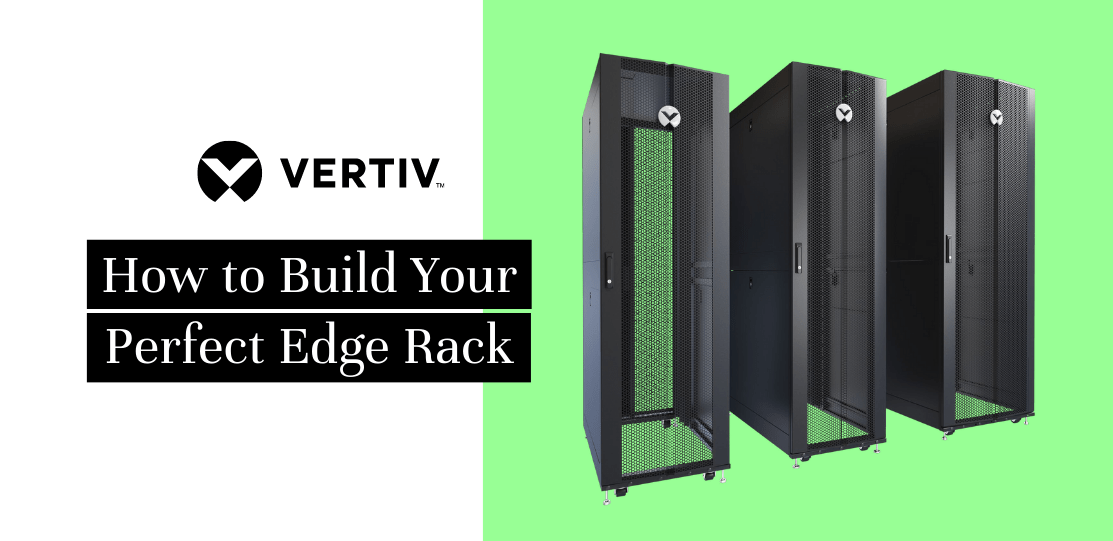
The Perfect Edge Rack Doesn’t Exist, but the Right One Does
When it comes to looking for a rack to support your edge developments, it’s important to realise there is no such thing as the perfect edge rack. There are so many different types of edge deployments that are supporting so many applications, that a single ‘perfect’ rack cannot exist. However, finding the right edge rack for your deployment is easy with Vertiv!
Step One – Finding the Right Size
Before you make any decisions on equipment or design, you first need to figure out the square footage of the space you have available. This will be the foundation of your rack hunt, impacting every decision you make going forward.
The space you have available will have implications throughout your project. The size of the room available will impact cooling options, security, how and where equipment can be deployed, and the route cables can take.
Most racks you will find will be a 42-rack unit (U) in height, and 19-inch in width, however, these measurements indicate the equipment that can be housed rather than the size of the rack itself. The 42U height and width are the standard measurement as it sizes racks appropriately for moving them easily in and out of standard facility doorframes. If you want to find the actual size of the rack to see if it fits your allocated space, you will need to consult the server rack model information as each manufacturer will size differently.
Standard rack depths are 1100mm or 1200mm, with just under an inch extra needed to allow for the doors to open and for rails to be mounted.
Step Two – Types of Server Racks Available
Within the rack itself, there are several options for how to configure it or the type of rack wanted to allow you to make sure your rack fits your specific needs. When choosing a rack for an edge deployment as space and environment can vary wildly.
The types of racks available to you include:
1. Cabinet enclosure
These types of racks provide robust physical security through a hard shell enclosing them. They are the most common form of rack and the most cost-effective. The models usually range between 6U and 48U.
2. Four-post open frame
These racks provide better ventilation through their open design but subsequently offer little physical security. Heights and depths for this usually range from 24U to 45U.
3. Wall-mount server rack
Perfect for when you are working with restricted space, these racks are mounted onto walls eliminating the traditional need for floor space. They typically will come fully enclosed and may include swing-out capabilities to improve your accessibility.
4. Dust and water-resistant server racks
Many edge deployments will be situated in industrial settings where excessive particulates and moisture are commonly around. Using a dust and water-resistant rack will give you the additional protection you will need to ensure the surrounding environmental factors don’t compromise the performance of IT equipment.
5. Self-contained server racks
To ensure climate control in any environment, these racks have a cooling capacity of between 800 to 12,000 British thermal units (BTU).
6. Portable server racks
Smaller than your typical rack, portable racks offer a lightweight, easy-to-move, and stackable option for when you need to move your rack between sites. Despite this, they are also durable and fully enclosed, ranging in size between 8U and 20U.
Step Three – Keeping it Cool
Maintaining the temperature and humidity in a rack is very different from in a data center due to the small space available. Even in small rack systems, power densities as low as 2 kW can generate enough heat to create issues due to the lack of space. As IT systems produce heat for as long as they are functioning for, they need a cooling method that will stay on for as long as they do. Without it, your equipment can quickly run into issues, especially with UPS systems whose battery life can be halved.
Perimeter Cooling
You can consider using a traditional configuration with a cool air delivery unit inside the room and a chiller outside if your computer room is on the perimeter of the building near a relatively secluded outside spot. The proximity of the inside and outside equipment is vital due to the copper pipe running between the two. The length of your copper pipe will affect the efficiency, with longer pipes being less efficient and more impractical.
In-rack Cooling Systems
Often, edge sites will need alternative cooling approaches to perimeter cooling. Using in-rack cooling systems is an effective and efficient cooling method, although it does require additional space to be available behind the rack to work. Some all-in-one racks will come with in-rack cooling systems already integrated.
Rear Door Heat Exchange Cooling Systems
These types of cooling systems are integrated into the rack door itself. They provide cool air evenly throughout the rack and are ideal for higher-density edge racks.
Step Four – Monitoring and Management
In modern architecture, edge data centers are integral parts of distributed networks consisting of similar sites that are designed to operate together seamlessly. They are also connected with enterprise data centers and cloud resources. Since most edge deployments lack on-site IT support, remote monitoring and management are crucial to prevent failures, delays, and downtime.
If you are considering remote management options for your edge rack, the first step is to identify the equipment in the rack. We recommend a console server with a cellular capability if it includes networking equipment. This will ensure that you can maintain visibility even if the network goes down by allowing you to access network gear remotely through a cellular connection. This will enable you to address problems remotely potentially.
On the other hand, if your rack contains servers, a keyboard, video, and mouse (KVM) switch are advisable. IT personnel can use a KVM to remotely access servers through an internet browser, conduct troubleshooting, or perform routine functions such as initiating equipment upgrades. Depending on the sensitivity of the data housed in the servers, you may want to consider a secure KVM. This is especially important if the data is sensitive to prevent unauthorized access.
If your rack has both networking equipment and servers, we recommend including both a console server and a KVM switch in your remote management options. It is essential to consider both current and future functions and potential vulnerabilities when making your decision.
Remote monitoring and management of edge data centers are vital to prevent failures, delays, and downtime. By identifying the equipment in your rack and selecting appropriate remote management tools, you can ensure seamless operation and minimize the risk of data breaches.
Available at Comms
Vertiv can meet all of your rack needs with its reliable portfolio of innovative products. Check out the Vertiv products we have available at Comms Express here.

For additional help or support with anything mentioned in this blog, or any other products that we stock, don’t hesitate to contact our team! Use our contact form to get in touch and our team will get back to you quickly with our expert knowledge!
This is just a brief look at the Vertiv Range, if you require more Vertiv equipment for your business, you can check our Vertiv microsite for a wide range of Vertiv products to suit your needs.
More Vertiv Products Available from Comms Express:
Vertiv Data Centre UPS | Vertiv Rack Cooling | Vertiv KVM & Console Drawer Solutions | Vertiv Server Cabinets | Vertiv PDUs | Vertiv UPS
If you require any further information on these or any other products that we stock here at Comms Express, please do not hesitate to contact our team who will be only too happy to help.
Until next time…
